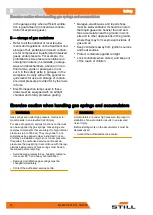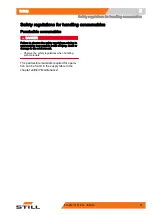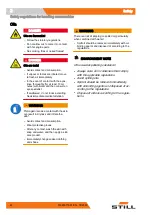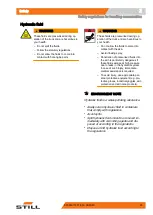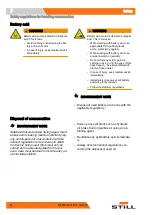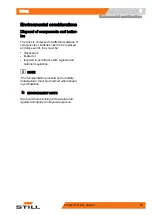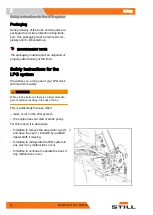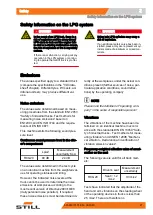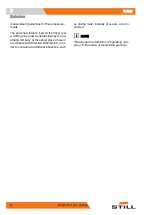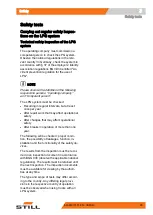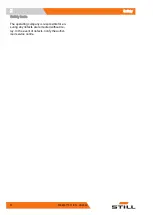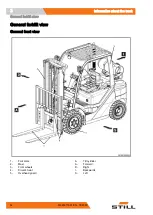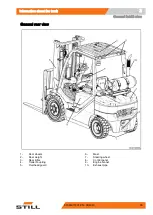
DANGER
LPG is highly flammable due to its volatility. Fur-
thermore, since it has a specific weight higher than
that of air (approximately twice the value), if the gas
leaks it remains suspended near the ground, thus
increasing the resulting hazard. It is prohibited to
park or leave the truck in closed and/or under-
ground environments.
General safety rules for liquid gas
The term "liquid gas" refers to BUTANE or
PROPANE or mixtures of BUTANE/
PROPANE supplied in bottles or particular
tanks and used for the propulsion of internal-
combustion engines.
The LPG quality must comply with the require-
ments of DIN 51622 as a minimum. The quali-
ty is optimum when the LPG complies with the
requirements of EN 589 (automotive gas).
DANGER
Risk of explosion! LPG is heavier than air; it diffu-
ses on the ground and spreads over large areas.
–
Trucks with LPG systems must only be parked in
sufficiently well-ventilated areas above ground
level.
–
They must not be parked near entrances to rooms
below ground level.
–
Sufficient space must be left around trucks that
have been parked; such areas must not include
cellar openings or cellar access points, pits or
similar cavities, drains without liquid seals, ventila-
tion shafts and light wells or combustible material.
DANGER
Risk of fire! Whenever LPG escapes, it immediately
becomes gaseous and therefore produces a poten-
tially explosive atmosphere. The vapours are heavi-
er than air and diffuse on the ground. Vapours
spread over large areas and can cause fires and
reignition.
LPG trucks and LPG cylinders must only be operated
and parked or stored in well-ventilated areas.
DANGER
Risk of explosion!
–
Do not smoke during maintenance work on LPG
systems, and make sure that there are no open
flames, stoves, lanterns or similar items located in
the vicinity.
–
Use only anti-static-treated tools that do not pro-
duce sparks.
–
Anti-static clothing and footwear are recommen-
ded.
Condition of the LPG cylinders
DANGER
LPG cylinders must not protrude beyond the edges
of the truck body because collisions with objects or
other trucks could cause them to be damaged.
There is a risk of explosion!
–
Only use LPG cylinders that have been approved
for operation of the LPG system.
Duties of the employer and the worker
The employer or the manager of the plant
where the liquid gas-powered industrial trucks
are used must ensure that these trucks are
used and maintained by suitably trained per-
sonnel only. The liquid gas-powered truck can
be put into service only after having checked
that it is in good condition.
The employer must provide company instruc-
tions for the industrial trucks used, written in a
simple and understandable format and con-
taining all the information necessary for safe
use of these trucks within the company activi-
ties. All the operators and maintenance per-
sonnel must be familiar with these instruc-
tions, and the instructions must always be
available and strictly followed in the work-
place.
Safety
2
General safety rules for liquid gas
18
60048011601 EN - 08/2020
Summary of Contents for RCG15
Page 2: ......
Page 4: ......
Page 10: ......
Page 11: ...1 Introduction ...
Page 19: ...2 Safety ...
Page 41: ...3 Information about the truck ...
Page 52: ...Information about the truck 3 Location of the decals 42 60048011601 EN 08 2020 ...
Page 53: ...4 Use and Operation ...
Page 122: ...Use and Operation 4 Decommissioning 112 60048011601 EN 08 2020 ...
Page 123: ...5 Maintenance ...
Page 159: ...6 Technical datasheet ...
Page 160: ...Dimensions Technical datasheet 6 Dimensions 150 60048011601 EN 08 2020 ...
Page 168: ...Technical datasheet 6 Mast specifications 158 60048011601 EN 08 2020 ...
Page 172: ......
Page 173: ......
Page 174: ...STILL GmbH 60048011601 EN 08 2020 ...
Page 176: ......
Page 177: ...7 Diagrams ...
Page 179: ...Hydraulic diagram Diagrams 7 Hydraulic diagram 169 60048011601 EN 08 2020 ...
Page 180: ...Diagrams 7 Hydraulic diagram 170 60048011601 EN 08 2020 ...
Page 181: ......
Page 182: ...STILL GmbH 60048011601 EN 08 2020 ...

















